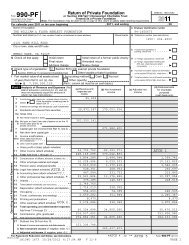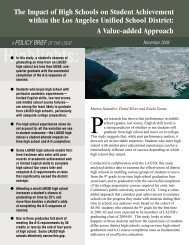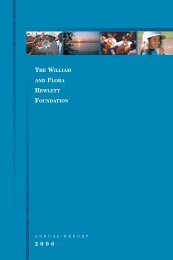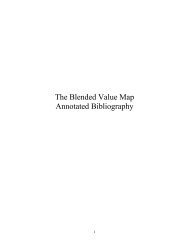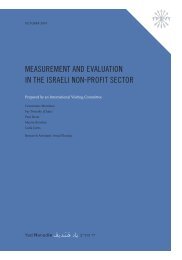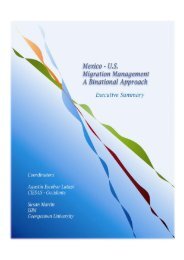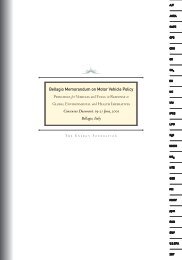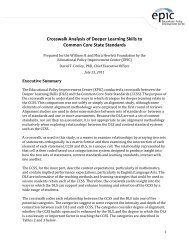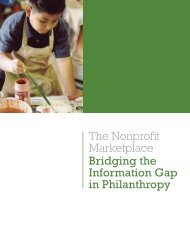EDUCATION FOR LIFE AND WORK - Hewlett Foundation
EDUCATION FOR LIFE AND WORK - Hewlett Foundation
EDUCATION FOR LIFE AND WORK - Hewlett Foundation
You also want an ePaper? Increase the reach of your titles
YUMPU automatically turns print PDFs into web optimized ePapers that Google loves.
Education for Life and Work: Developing Transferable Knowledge and Skills in the 21st Century<br />
30 <strong>EDUCATION</strong> <strong>FOR</strong> <strong>LIFE</strong> <strong>AND</strong> <strong>WORK</strong><br />
• Extroversion (warmth, gregariousness, assertiveness, activity, excitement<br />
seeking, positive emotions)<br />
• Openness to experience (fantasy, aesthetics, feelings, actions, ideas,<br />
values)<br />
To the facets of the neuroticism/emotional stability factor proposed<br />
by Costa and McCrae (1992) we added “core self-evaluation,” based on a<br />
proposal by Judge and Bono (2001). This additional proposed construct is<br />
based on empirical findings of correlations between measures of self-esteem,<br />
generalized self-efficacy, locus of control, 3 and emotional stability. Almlund<br />
et al. (2011) also found that self-esteem and locus of control are related to<br />
emotional stability.<br />
The five major factors provided a small number of research-based constructs<br />
onto which various terms for 21st century skills could be mapped.<br />
The facets helped to define the range of skills and behaviors encompassed<br />
within each major factor to serve as a point of comparison with the various<br />
21st century skills.<br />
Formative Latent Variables: Occupational Skills and Other Examples<br />
Unlike reflective latent variables that are discovered, formative latent<br />
variables are constructed. Relationships between variables do not constrain<br />
the development of formative latent variables; rather, formative latent variables<br />
can be whatever a person or community defines them to be. Classic<br />
examples appear in economics, such as the consumer price index; in health,<br />
such as the stress index; and in business research, such as leadership or positive<br />
experience with a product (Jarvis, Mackenzie, and Podsakoff, 2003).<br />
One set of formative latent variables that may be particularly relevant<br />
for defining 21st century competencies was identified through expert consensus<br />
in the O*NET project (Peterson et al., 1999). O*NET is a large<br />
database of information on 965 occupations that is organized around a<br />
“content model,” which describes occupations along several dimensions,<br />
including worker characteristics (abilities, interests, work values, and work<br />
styles) and requirements (skills, knowledge, and education). The skills included<br />
in the O*NET content model are similar to those in current lists of<br />
21st century lists, as shown in Table 2-1.<br />
3<br />
In differential psychology, locus of control refers to the extent to which individuals believe<br />
that they can control their own lives (an internal locus of control) or that outside influences<br />
control what happens (an external locus of control), as measured by the Rotter scale (Rotter,<br />
1990). The “locus of control” construct has been criticized as being too general, and most<br />
researchers currently differentiate beliefs about causality as delineated in attribution theory.<br />
Copyright © National Academy of Sciences. All rights reserved.




